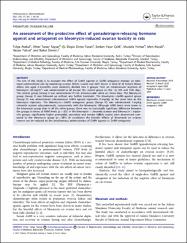An assessment of the protective effect of gonadotropin-releasing hormone agonist and antagonist on bleomycin-induced ovarian toxicity in rats

Göster/
Tarih
2020Yazar
Atakul, TolgaTayyar, Ahter Tanay
Turan, Ozgur Deniz
Çelik, Serkan Yaşar
Yilmaz, Mustafa
Küçük, Mert
Demirci, Buket
Üst veri
Tüm öğe kaydını gösterÖzet
The aim of this study is to evaluate the effect of GnRH agonist or GnRH antagonist therapy on bleomycin-administered rats by examining ovarian follicle counts and AMH levels. A total of 30 female Wistar albino rats aged 4-6 months were randomly divided into 4 groups. First, an intramuscular injection of bleomycin (30 mg/m(2)) was administered to all except the control group on the 1st, 8th and 15th days. The control group (Group I) was administered 0.1 mL intramuscular saline on those days. The bleomycin group (Group II) was followed up without any further treatment. The bleomycin + GnRH agonist group (Group III) was administered subcutaneous GnRH agonist triptorelin (1 mg/kg) at the same time as the bleomycin injections. The bleomycin + GnRH antagonist group (Group IV) was administered 1 mg/kg cetrorelix acetate subcutaneously, concurrently with the bleomycin. Although AMH levels were lower in the bleomycin group than in all the other groups, there was no statistically significant difference between the groups in terms of AMH levels (p > .05). In the bleomycin + cetrorelix acetate and bleomycin + triptorelin groups, significantly higher primordial, secondary and tertiary follicle counts were determined compared to the bleomycin group (p < .001). In conclusion the harmful effects of bleomycin on ovarian reserve can be reduced by the simultaneous administration of GnRH agonist or GnRH antagonist.

















